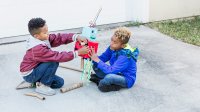5 Ways to Give Students a Makerspace Experience at Home
Hands-on projects that use inexpensive materials and focus on multiple iterations help make learning fun.
As districts reel to meet the evolving needs of their communities beset by a pandemic, the loss of experiential, maker-centered learning seems inevitable. Teachers in remote or hybrid settings face a real challenge, made all the more urgent by the need for students to engage in tactile learning away from ubiquitous screens. But there are strategies you can use to help your students bring a bit of maker culture home.
5 Strategies for Offering Hands-On Projects Remotely
1. Integrate choice. Student-centric learning design has always heavily featured student choice, and it’s the right time to lean into it even more. Choice grants focused autonomy to students, affording them a sense of control in uncertain times. It also makes a positive result more achievable. We can’t possibly imagine and plan for all the hurdles in each student’s home, and offering a more open-ended process or product can give students the leeway and the license to navigate their environments successfully. Choice has the added benefit of allowing your students to exercise and appreciate multiple modalities and intelligences.
When my third graders began learning about forces in motion, I gave them the option to design a real physical “golf” course using any ball and whatever building blocks they might have had available (recyclables, Lego Duplos, wooden blocks, or even furniture). Those without the materials, or who were learning at a house that wasn’t their own, were invited to use a digital simulation of tug-of-war from PhET, a product of the University of Colorado Boulder that provides free, interactive math and science simulations. Everyone learned in ways that were meaningful and accessible to them, and their end-of-lesson discussion was much richer due to the varied and diverse experiences of their peers.
2. Keep it accessible by using what they likely already have. Being cognizant of what materials you request and making an effort to avoid those that are expensive, out of the ordinary, or both can help all students to find your remote projects accessible. In a climate where pennies are counted more carefully and extra trips out of the home are avoided, don’t add to the problem by requiring items that aren’t likely to be in the home already. It’s a great time for reusing recyclables and making things that are easy to deconstruct, without having ruined the materials that went into them.
When my third graders tested out centripetal force, I had them tie any kind of string (ribbon, twine, fishing line, yarn, even a shoelace) around any kind of small soft thing (cotton ball, stuffed animal). I used a single tissue in my example. No matter what they used, they were able to fling it around in a circle to demonstrate centripetal force and then take it apart and still have perfectly usable materials. When I require drippy glue, I include a recipe for a DIY, make-from-home-with-common-ingredients option.
3. Offer pickup for materials, as many districts have done for classroom materials. Many districts have a procedure in place for materials to be picked up weekly or as needed by parents or families, often in conjunction with free meal pickup. Consider this option for oddball materials that would be high impact for your instruction, especially those that could be considered consumable, like plastic pipettes. Include instructions for care, and accept news of loss or damage with grace.
4. Capitalize on parent/family participation. For some families, a silver lining of remote and hybrid learning is the increased participation of parents and family members. Parents who might not have their finger on the pulse of the science, technology, engineering, and math classroom in more normal times now have the opportunity to cheer on their children, share advice or encouragement, and even lend a hand. Think about giving an option for your project to be completed with help from family members, especially in younger grades. Create a platform for parents to share praise or report something they’ve learned from their child. Not all home environments are positive, and not all adults can give this time; be cognizant of this and show grace. Give room in your grading systems.
Around Thanksgiving, my second graders made shelters for Pilgrims out of recyclables and tested them out against high winds (a hair dryer or fan) and snow (cotton balls, marshmallows, etc.). Families were welcome to pitch in, and I had so many who enjoyed working together.
5. Celebrate iterations. One of the most important parts of a makerspace classroom, and one of the most painfully absent in our current climate, is an opportunity for iterative learning. Having the opportunity to start something, try it out, make adjustments, and try again is central to the idea of the student as the maker, and it’s really hard to do today. I recommend swapping our focus from the product to the process. Design a very flexible project, and have the students’ main task be to document their design changes. Set up a scavenger hunt, and require them to report one item they fixed, one thing that worked well from the outset, and one thing they scrapped entirely. Or, have the final product actually be a collaged layout of pictures of their progress, showing how their thinking evolved.
It’s so valuable to steer our classrooms back toward the pillars of experiential learning that we value so much. By offering learning opportunities that capitalize on maker-centered tenets, we take important steps to fill these voids.
